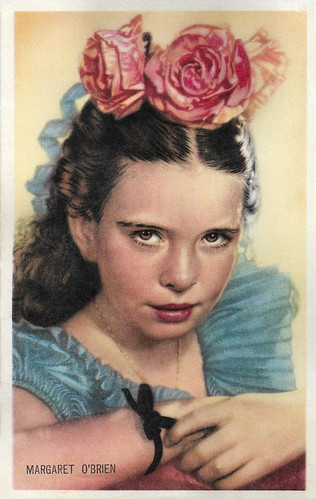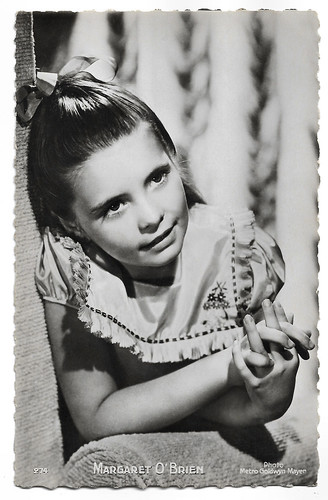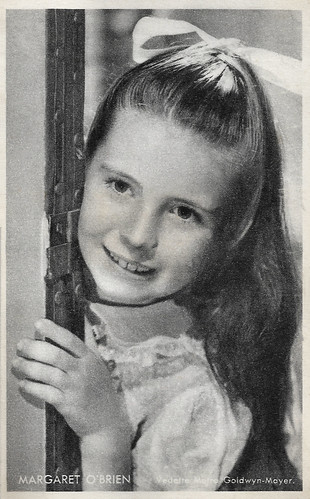
British postcard in the Picturegoer Series, London, no. B 7. Photo: Metro-Goldwyn-Mayer.

British collectors card by Kwatta, Bois-d'Haine, no. C. 202 (Series C 197 to C 228). Photo: MGM.
Her quite convincing acting style, unusual for a child of her age
Margaret O'Brien was born Angela Maxine O'Brien in 1937. O'Brien's mother, Gladys Flores, was a flamenco dancer who often performed with her sister Marissa, who was also a dancer.
At the age of four, she appeared in a WWII civil defence film and made a minor appearance in her first feature film, a one-minute shot in Babes on Broadway (Busby Berkeley, 1941) under her birth name, Maxine O'Brien.
Impressed by the child's expressiveness and emotional range, Metro-Goldwyn-Mayer signed her as a contract player. The studio changed her first name and cast her in the title role of the war drama Journey for Margaret (W.S. Van Dyke, 1942). As a five-year-old, she played a terrified London war orphan who "adopts" reporter Robert Young.
Her first major role in Journey for Margaret brought her widespread attention. O'Brien won wide praise for her quite convincing acting style, unusual for a child of her age. By 1943, she was considered a big enough star to have a cameo appearance in the all-star military show finale of Thousands Cheer (George Sidney, 1943).
Also In 1943, at the age of seven, Margaret co-starred in You, John Jones (Mervyn LeRoy, 1943), a 'War Bond/Effort, short film, with James Cagney and Ann Sothern. She played their daughter and dramatically recited President Lincoln's 'Gettysburg Address'. She played Adèle, a young French girl, and spoke and sang all her dialogue with a French accent in Jane Eyre (Robert Stevenson, 1943) opposite Orson Welles and Joan Fontaine.

French postcard by Editions P.I., Paris, no. 274. Photo: MGM, 1946.

Dutch postcard by Takken, no. 3527. Photo: Metro Goldwyn Mayer. Margaret O'Brien and Cyd Charisse in The Unfinished Dance (Henry Koster, 1947).
A bright point in a very good film
Margaret O'Brien's most memorable role was in the Christmas musical Meet Me in St. Louis (Vincente Minnelli, 1944). As Tootie Smith, the feisty but fragile little sister of Judy Garland, she was a bright point in a very good film, especially in her musical numbers with Garland and during a Halloween sequence in which she confronts a grouchy neighbour.
For her performance, she was awarded a special juvenile Oscar in 1944. Upon its release, Meet Me in St. Louis was both a critical and commercial success. It became the second-highest-grossing film of 1944, behind only Going My Way (Leo McCarey, 1944), and was also MGM's most successful musical of the 1940s.
Her other successes included The Canterville Ghost (Jules Dassin, 1944) starring Charles Laughton, Our Vines Have Tender Grapes (Roy Rowland, 1945) with Edward G. Robinson, the Western Bad Bascomb (S. Sylvan Simon, 1946) with Wallace Beery, and the first sound version of The Secret Garden (Fred M. Wilcox, 1949).
She played Beth in the 1949 MGM release of Little Women (Mervyn Le Roy, 1949) with June Allyson, but she could not transition to adult roles. Hal Erickson at AllMovie: "As she grew, her charm faded; by 1951's Her First Romance (Seymour Friedman, 1951), she was just one of a multitude of Hollywood teen ingenues. A comeback attempt in the 1956 film Glory (David Butler, 1956) was serviceable, but the film was badly handled by its distributor RKO Radio and failed to re-establish the actress.
A more fruitful role awaited her in a TV musical version of Little Women (William Corrigan, 1958), in which O'Brien played Beth, the same role she'd essayed in the 1949 film version. In 1960, O'Brien had a strong supporting part in the period picture Heller in Pink Tights (George Cukor, 1960), ironically playing a one-time child actress whose stage mother is trying to keep her in "kid" roles."

Belgian collectors card by Kwatta, Bois d'Haine, no. C. 15. Photo: Metro-Goldwyn-Mayer.

Belgian collectors card by Kwatta, Bois-d'Haine, no. C. 16 (Series C 1 to C 98). Photo: Metro Goldwyn Mayer (MGM).

Belgian collectors card by Kwatta, Bois-d'Haine, no. C. 185. Photo: Metro-Goldwyn-Mayer. Margaret O'Brien and Phyllis Thaxter (not Teresa Wright!) in Tenth Avenue Angel (Roy Rowland, 1948).
The stolen Oscar
Margaret O'Brien shed her child star image, appearing on a 1958 cover of Life magazine with the caption "How the Girl's Grown", and was a mystery guest on the TV panel show What's My Line? O'Brien's acting appearances as an adult have been sporadic, mostly in small independent films and occasional television roles.
She has also given interviews, mainly for the Turner Classic Movies cable network. O'Brien gave credit to television for helping her reform and modify her public image. On Robert Montgomery Presents on TV, she co-starred with Cecil Parker in The Canterville Ghost (1950). She appeared as the mystery guest on What's My Line (1957) and starred in The Young Years (1957) on General Electric Theater.
She appeared in episodes of the Western series Rawhide and Wagon Train (1958) and later made guest appearances on episodes of Perry Mason (1963), Combat! (1968) and Ironside (1968). Another rare television outing was as a guest star on the popular Marcus Welby, M.D., reuniting O'Brien with her Journey for Margaret and The Canterville Ghost co-star Robert Young. In 1991, O'Brien appeared in an episode of Murder, She Wrote, starring Angela Lansbury.
In 1954, O'Brien's Juvenile Oscar and two other awards were stolen. Several years later, a miniature statuette bearing O'Brien's name surfaced in a catalogue for an auction. The long-lost Oscar was found by two memorabilia collectors in a flea market in 1995 and, upon learning of the award's history, the two owners agreed to return the Oscar to O'Brien. Nearly 50 years after she had first received it, and nearly 40 years since it had been stolen, the Academy held a special ceremony in Beverly Hills to return the stolen award to O'Brien.
Margaret O'Brien has been married twice, to Harold Allen, Jr. from 1959 to 1968, and in 1974 to steel-industry executive Roy Thorvald Thorsen. The later marriage produced her only child, Mara Tolene Thorsen, born in 1977. O'Brien continues to appear in such films as the horror film Halloween Pussy Trap Kill! Kill! (Jared Cohn, 2017) and the Sci-Fi film Impact Event (B. Luciano Barsuglia, 2018).

Vintage card. Photo: Metro-Goldwyn-Mayer.

British postcard in the Picturegoer Series, London, no. W 282. Photo: Metro-Goldwyn-Mayer.
Sources: Hal Erickson (AllMovie), Rotten Tomatoes, Wikipedia and IMDb.
No comments:
Post a Comment